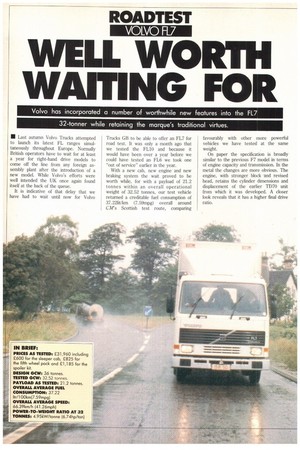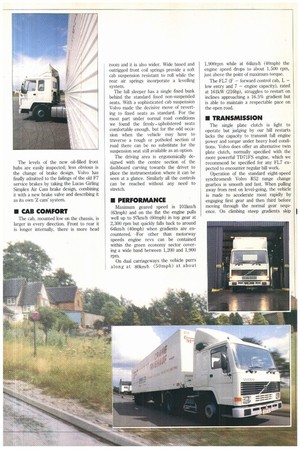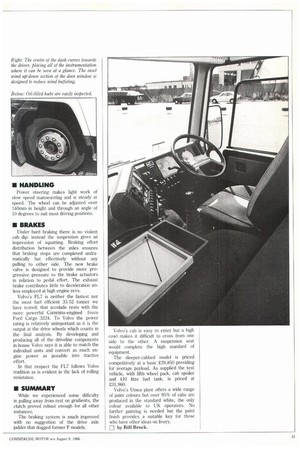WELL WORM WAITING FOR
Page 30

Page 31

Page 32

Page 33

If you've noticed an error in this article please click here to report it so we can fix it.
Volvo has incorporated a number of worthwhile new features into the FL7 32-tonner while retaining the marque's traditional virtues.
II Last autumn Volvo Trucks attempted to launch its latest FL ranges simultaneously throughout Europe. Normally British operators have to wait for at least a year for right-hand drive models to come off the line from any foreign assembly plant after the introduction of a new model. While Volvo's efforts were well intended the UK once again found itself at the back of the queue.
It is indicative of that delay that we have had to wait until now for Volvo Trucks GB to be able to offer an FL7 for road test. It was only a month ago that we tested the FLIO and because it would have been over a year before we could have tested an FL6 we took one "out of service" earlier in the year.
With a new cab, new engine and new braking system the wait proved to be worth while, for with a payload of 21.2 tonnes within an overall operational weight of 32.52 tonnes, our test vehicle returned a creditable fuel consumption of 37.221it/km (7.59mpg) overall around CM's Scottish test route, comparing
favourably with other more powerful vehicles we have tested at the same weight.
On paper the specification is broadly similar to the previous F7 model in terms of engine capacity and transmission. In the metal the changes are more obvious. The engine, with stronger block -and revised head, retains the cylinder dimensions and displacement of the earlier TD70 unit from which it was developed. A closer look reveals that it has a higher final drive ratio.
The levels of the new oil-filled front hubs are easily inspected; less obvious is the change of brake design. Volvo has finally admitted to the failings of the old F7 service brakes by taking the Lucas Girling Simplex Air Cam brake design, combining it with a new brake valve and describing it as its own 'Z cam' system.
• CAB COMFORT
The cab, mounted low on the chassis, is larger in every direction. Front to rear it is longer internally, there is more head room and it is also wider. Wide based and outrigged front coil springs provide a soft cab suspension resistant to roll while the rear air springs incorporate a levelling system.
The full sleeper has a single fixed bunk behind the standard fixed non-suspended seats. With a sophisticated cab suspension Volvo made the decisive move of reverting to fixed seats as standard. For the most part under normal road conditions we found the firmly-upholstered seats comfortable enough, but for the odd occasion when the vehicle may have to traverse a rough or potholed section of road there can be no substitute for the suspension seat still available as an option.
The driving area is ergonomically designed with the centre section of the dashboard curving towards the driver to place the instrumentation where it can be seen at a glance. Similarly all the controls can be reached without any need to stretch.
• PERFORMANCE
Maximum geared speed is 101km/h (63mph) and on the flat the engine pulls well up to 971cm/h (60mph) in top gear at 2,300 rpm but quickly falls back to around 641cm/h (40mph) when gradients are encountered. -For other than motorway speeds engine revs can be contained within the green economy sector covering a wide band between 1,200 and 1,900 rpm.
On dual carriageways the vehicle purrs along at 801cm/h (5 Omph) at about 1,900rpm while at 64km/h (40mph) the engine speed drops to about 1,500 rpm, just above the point of maximum torque.
The FL7 (F — forward control cab, L — low entry and 7 — engine capacity), rated at 161kW (216hp), struggles to restart on inclines approaching a 16.5% gradient but is able to maintain a respectable pace on the open road.
• TRANSMISSION
The single plate clutch is light to operate but judging by our hill restarts lacks the capacity to transmit full engine power and torque under heavy load conditions. Volvo does offer an alternative twin plate clutch, normally specified with the more powerful TD71FS engine, which we recommend be specified for any FL7 expected to encounter regular hill work.
Operation of the standard eight-speed synchromesh Volvo R52 range change gearbox is smooth and fast. When pulling away from rest on level-going, the vehicle is made to accelerate most rapidly by engaging first gear and then third before moving through the normal gear sequence. On climbing steep gradients skip changes are necessary and easily carried out as the vehicle slows.
Reverse, next to first, is protected by a spring but that is all too easily overridden when hastily skip changing down from third gear to first.
With the cab floor height 110mm lower than on the previous model, the driver sits low down next to the high engine cowl which divides the cab and prevents easy cross-cab access. The front screen extends well above head height allowing unobstructed vision of traffic lights and road signs. Large door windows feature recessed wind up/down sections that can be lowered without causing buffeting.
A glass fibre lip on the front A-post directs rain water deposited on the front screen over the cab roof to keep the sides clear. Vents in the door's swaged panel direct air from the front grille, also helping to keep the doors clean. Aerodynamic mirror heads are designed to prevent the glass from fouling and in the rain the heater element can be used to dry off any spray that does settle.
Full width sun visors, better than those of the F7 which left a gap in the middle, are complemented by side-mounted visors located above the doors.
Vents in the doors are the same as for the F10 so that side windows are demisted at the same time as the front screen.
• HANDLING
Power steering makes light work of slow speed manoeuvring and is steady at speed. The wheel can be adjusted over 140mm in height and through an angle of 10 degrees to suit most driving positions.
• BRAKES
Under hard braking there is no violent cab dip: instead the suspension gives an impression of squatting. Braking effort distribution between the axles ensures that braking stops are completed undramatically but effectively without any pulling to either side. The new brake valve is designed to provide more progressive pressure to the brake actuators in relation to pedal effort. The exhaust brake contributes little to deceleration unless employed at high engine revs.
Volvo's FL7 is neither the fastest nor the most fuel efficient 35.52 tonner we have tested; that accolade rests with the more powerful Cummins-engined lveco Ford Cargo 3224. To Volvo the power rating is relatively unimportant as it is the output at the drive wheels which counts in the final analysis. By developing and producing all of the driveline components in-house Volvo says it is able to match the individual units and convert as much engine power as possible into tractive effort.
In that respect the FL7 follows Volvo tradition as is evident in the lack of rolling resistance.
• SUMMARY
While we experienced some difficulty in pulling away from rest on gradients, the clutch proved robust enough for all other instances.
The braking system is much improved with no suggestion of the drive axle judder that dogged former F models. Volvo's cab is easy to enter but a high cowl makes it difficult to cross from one side to the other. A suspension seat would complete the high standard of equipment.
The sleeper-cabbed model is priced competitively at a basic £29,850 providing for average payload. As supplied the test vehicle, with fifth wheel pack, cab spoiler and 410 litre fuel tank, is priced at £31,960.
Volvo's Umea plant offers a wide range of paint colours but over 95% of cabs are produced in the standard white, the only colour available to UK operators. No further painting is needed but the paint finish provides a suitable key for those who have other ideas on livery.
D by Bill Brock.




































































































